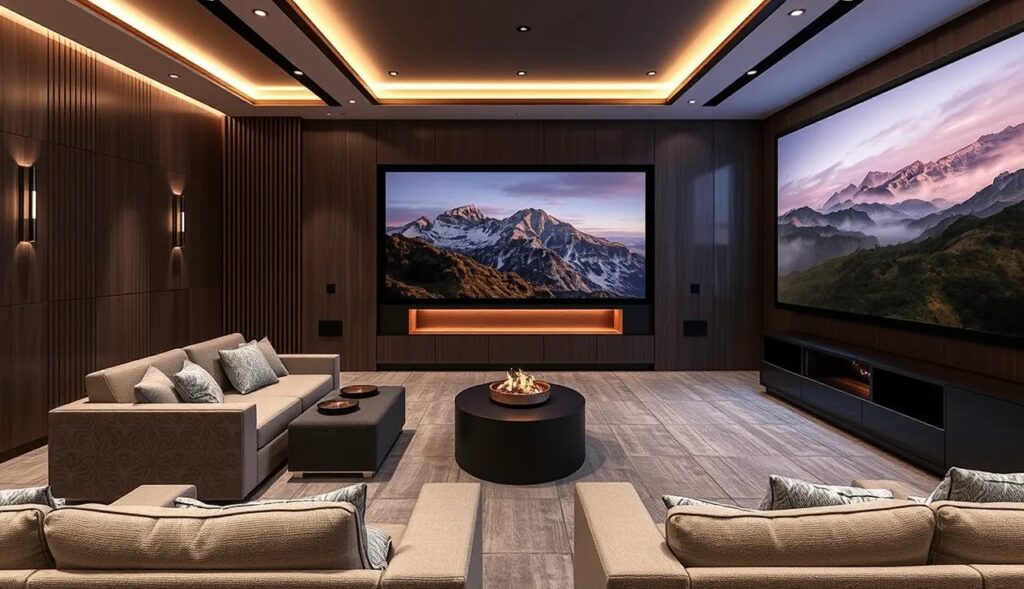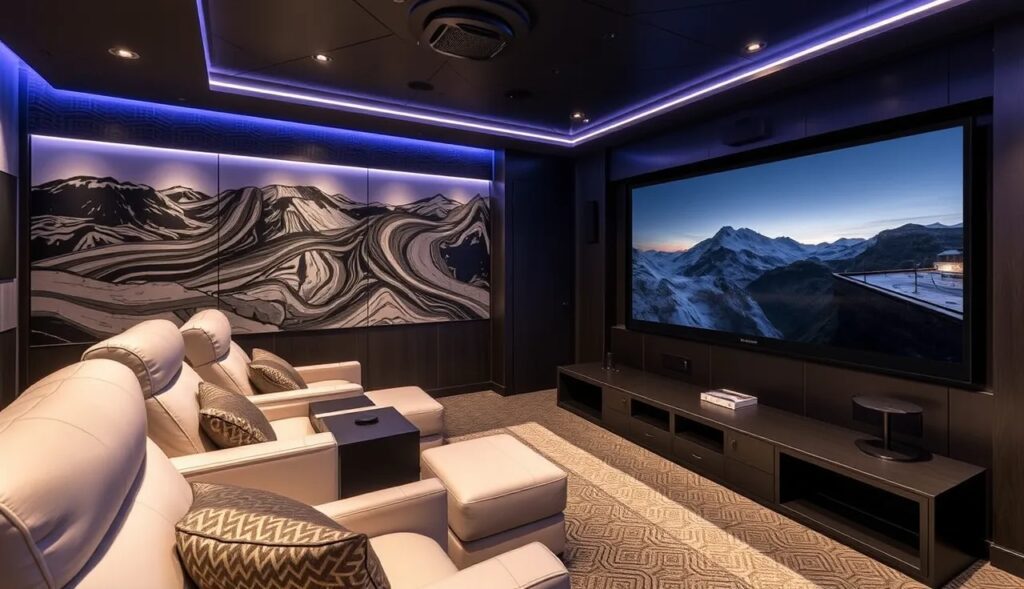
The Evolution of Home Entertainment
From Static to Dynamic Experiences
Home theaters have come a long way from basic setups. AI has ushered in a new era where systems adjust dynamically to your preferences. Picture this: your lighting dims automatically, sound surrounds you perfectly, and visuals are optimized in real time.
This evolution means no more manual tweaking. The system knows your habits, preferences, and even the time of day. It’s immersive, seamless, and effortless.
Why AI Integration Is Game-Changing
AI doesn’t just upgrade—it transforms. By learning patterns, it creates tailored cinematic experiences. Watching a suspense thriller? Expect lights that react to sudden plot twists. Hosting a party? AI fine-tunes soundtracks for the perfect vibe.
With this, your living room isn’t just smart—it’s intelligent. The entire system feels like it anticipates your needs before you even voice them.
Smarter Lighting for Enhanced Ambiance
Adaptive Lighting for Every Scene
Imagine the lights adjusting automatically based on the movie genre. AI-powered lighting systems, like those from Philips Hue or LIFX, offer this capability. Soft glows during romantic scenes, or dynamic strobes during action sequences, elevate the experience.
The magic lies in AI’s ability to sync with visuals and create the perfect ambiance. It’s like having a professional lighting designer at your fingertips.
Voice-Controlled and Gesture-Based Commands
Feeling lazy? No problem. AI allows you to control lighting with a simple voice command or a wave of your hand. Integrations with systems like Alexa or Google Home make it easy to say, “Dim the lights,” or “Set theater mode.”
Gesture recognition adds another layer. Wave up to brighten or down to dim. It’s intuitive and hassle-free.
Precision Audio for Immersive Sound
AI-Driven Acoustic Optimization
Sound matters just as much as visuals, and AI ensures it’s pitch-perfect. These systems analyze room dimensions, furniture placement, and user preferences to calibrate ideal acoustics.
Brands like Sonos and Bose are already leveraging AI to create 360-degree soundscapes. You’ll feel every whisper, crash, and crescendo as if you were part of the scene.
Personalized Sound Profiles
AI adapts sound based on who’s in the room. Love bass-heavy beats? AI amplifies the low end. Prefer clear dialogue? It enhances voice clarity without manual adjustments.
The system might even lower volumes at night for a neighbor-friendly experience. Talk about thoughtful tech.
Visuals That Adapt in Real-Time
AI-Enhanced Resolution
Forget standard 4K. AI takes visuals up a notch with dynamic upscaling. Systems like Nvidia Shield or Sony’s Bravia TVs use machine learning to sharpen low-res content, making older movies look stunning.
Every frame is analyzed and optimized in milliseconds, offering deeper colors and crisp details. It’s like rediscovering your favorite films for the first time.
Scene-Based Brightness Adjustments
AI adjusts screen brightness based on the environment. Watching in daylight? It enhances contrast and reduces glare. In the dark? The system tones down brightness for eye comfort.
This eliminates constant remote fiddling, keeping the focus on enjoying the movie.

Multi-Sensory Immersion
Combining Light, Sound, and Visuals
When lighting, sound, and visuals work together, the result is a deeply immersive experience. AI systems like Ambilight TVs integrate these elements to make every scene feel tangible. A battle in the movie might synchronize with dramatic lighting flashes and booming sound effects, transporting you into the thick of the action.
This multi-sensory approach is what sets AI-powered home theaters apart. They don’t just display content—they make you feel it.
Gamers’ Paradise: Interactive Immersion
For gamers, immersion is about interaction. AI-powered setups integrate with gaming systems to create adaptive environments. Racing games, for instance, might use AI to sync lighting and sound with on-screen speed and weather conditions, putting you right in the driver’s seat.
Gamers using systems like Xbox or PlayStation paired with AI home theaters report heightened awareness and engagement, making victories feel even more rewarding.
AI-Powered Customization at Your Fingertips
Learning and Adapting Over Time
The more you use an AI home theater, the smarter it gets. Over time, it learns your habits, optimizing every aspect—be it lighting, sound, or visuals.
Frequent rewatch of a certain genre? Expect tweaks that match the mood perfectly. This personalization is what sets AI apart from traditional systems.
Centralized Control with Apps
Most AI systems come with dedicated apps. These let you control everything from your phone, from calibrating audio settings to choosing lighting presets.
Think of it as a one-stop-shop for fine-tuning your home theater experience.
Integration with Smart Ecosystems
Seamless Connectivity with Smart Devices
AI-powered home theaters thrive when connected to other smart devices. Systems like Apple HomeKit, Samsung SmartThings, or Amazon’s Alexa create a unified ecosystem where everything syncs seamlessly.
For instance, starting your movie can automatically close the blinds, adjust the thermostat, and prep your popcorn maker. It’s automation at its best.
IFTTT and Cross-Platform Compatibility
“If This Then That” (IFTTT) recipes enhance customization. Pair your home theater with your coffee maker for weekend morning binge sessions. Compatibility with multiple platforms ensures you’re not locked into a single brand.
The result? A connected environment that adapts to your lifestyle effortlessly.
The Role of AI in Content Discovery
Smarter Recommendations for Movie Nights
Struggling to pick a movie? AI can curate personalized lists based on your mood, preferences, and watch history. Platforms like Netflix and Prime Video already use machine learning algorithms to suggest content you’ll love.
Home theater systems take it further. Integrated AI assistants might suggest movies you missed or create themed playlists for family nights or solo marathons.
Voice-Activated Searches
Voice assistants like Siri or Google Assistant make searching a breeze. A simple “Find action movies from the 90s” saves you scrolling time. These systems also integrate with streaming apps, making navigation smoother than ever.

Future Trends in AI-Powered Home Theaters
Predictive Maintenance with AI
One of the coolest advancements? AI systems predict potential issues before they happen. From speaker malfunctions to software updates, your theater can self-diagnose and notify you, minimizing downtime.
This proactive approach extends the system’s lifespan while ensuring optimal performance.
Virtual and Augmented Reality Integration
Imagine blending VR or AR into your home theater setup. AI could transform your living room into a battleground or magical forest, making the experience interactive.
These immersive elements are the next frontier, offering an entertainment experience that feels limitless.
Sustainability in AI-Powered Theaters
Energy-Efficient Features
AI-driven systems prioritize sustainability. From auto power-off features to eco-friendly brightness settings, these setups reduce energy consumption.
Some systems even analyze your power usage and suggest settings to save costs without sacrificing quality.
Eco-Conscious Design and Materials
Tech companies are increasingly embracing sustainable materials. Expect AI-powered systems to use recyclable components and packaging, making them a greener choice for your home.
Ready to Transform Your Home Theater?
AI-powered home theaters aren’t just about smarter tech—they redefine entertainment. Whether it’s custom lighting, immersive sound, or cutting-edge visuals, they adapt to your every need, creating a personalized and unforgettable experience.
Want to dive into this futuristic world? Start small with lighting upgrades or go big with a full AI-powered setup. Either way, your home entertainment is about to get a whole lot smarter.
FAQs
How does AI improve home theater sound quality?
AI optimizes sound by analyzing your room’s layout, adjusting audio levels for ideal acoustics, and tailoring sound profiles. For instance, AI might enhance bass for action movies or amplify dialogue for dramas.
A great example is the Sonos Arc soundbar, which uses AI to adjust audio for wall reflections and ceiling height, delivering immersive surround sound without extra speakers.
Can I control everything with my voice?
Absolutely! AI-powered home theaters integrate with voice assistants like Alexa, Siri, or Google Assistant, allowing hands-free control. You can say, “Start movie night,” and the system dims the lights, turns on the projector, and adjusts the sound.
Some setups even include custom voice commands, like setting “Game Mode” to turn up the brightness and emphasize audio effects during sports broadcasts.
Are these systems compatible with older devices?
Yes, most AI systems offer backward compatibility. Devices like Nvidia Shield can upscale old DVDs to near-4K quality, breathing new life into your classic collection.
Streaming services like Netflix and Hulu often work seamlessly with AI-powered systems, meaning you won’t miss out on modern features even with older tech.
Do AI-powered theaters save energy?
Yes, many systems prioritize energy efficiency. For example, AI-enabled projectors can adjust brightness based on room lighting, reducing power usage during the day.
Additionally, auto-off features ensure unused devices don’t drain electricity. Systems like LG’s AI ThinQ TVs track power usage and offer suggestions to optimize energy savings.
Can AI learn my preferences over time?
Yes! AI continuously adapts to your habits. For example, if you consistently watch romantic comedies, the system might adjust the lighting to warm tones and recommend similar genres.
Platforms like Google TV go a step further by curating personalized watchlists based on your viewing patterns, ensuring a tailored experience every time.
What about integrating with smart home systems?
AI-powered home theaters seamlessly integrate with platforms like Amazon Alexa, Apple HomeKit, and Samsung SmartThings. For instance, saying “Goodnight” might pause your movie, turn off the lights, and lower the room temperature automatically.
Using IFTTT recipes, you can also create unique actions, like syncing your coffee maker with Saturday morning movie marathons.
Are these systems beginner-friendly?
Definitely! Most setups come with intuitive apps and step-by-step guides. For example, Samsung’s SmartThings app simplifies connecting all devices in your ecosystem.
AI also eliminates much of the guesswork. Instead of tweaking settings manually, you can rely on presets like “Movie Night” or “Gaming Mode.”
Can I customize lighting for different moods?
Yes! AI lighting systems like Philips Hue adjust to match your mood or the scene. Watching a horror movie? The system might dim to eerie tones. Hosting a party? Expect colorful strobes to sync with music beats.
These features make every moment more engaging, whether you’re relaxing or entertaining guests.
Can AI improve older, non-smart TVs or sound systems?
Yes! AI-powered devices like external media players (e.g., Nvidia Shield or Amazon Fire Stick) can upgrade older TVs. These tools enable features like content upscaling, voice control, and app integrations even on non-smart setups.
For sound systems, AI-driven AV receivers recalibrate audio for modern surround sound, making older equipment feel brand new.
Are AI-powered home theaters worth the investment?
Absolutely, especially if you’re looking for customization and ease of use. While the upfront cost may be higher, the automation, energy efficiency, and improved experience can justify the investment.
For instance, AI-powered lighting and sound reduce manual adjustments, saving time and effort. Plus, personalized movie recommendations make content discovery a breeze.
How does AI handle multiple users in one household?
AI systems create user profiles to adapt to each person’s preferences. For example, one family member might get recommendations for thrillers, while another sees options for comedies.
Even sound and lighting preferences can differ by profile. Imagine your teen’s gaming mode seamlessly switching to movie night ambiance when it’s your turn.
Do AI-powered systems require an internet connection?
Yes, most systems rely on the internet for updates, content streaming, and smart assistant features. However, many devices have offline functionality too. For example, AI projectors and soundbars can still adjust settings and optimize playback without an active connection.
That said, to enjoy features like voice commands, streaming, or personalized recommendations, a stable internet connection is key.
Are AI-powered systems secure?
Modern systems prioritize data security. For example, brands like Google and Apple include encryption and privacy settings to safeguard your information.
You can take extra steps by using strong passwords and reviewing app permissions to ensure your data remains protected.
What happens if AI gets it wrong?
Occasionally, AI may make errors in sound calibration or lighting settings, but most systems allow for manual overrides.
For instance, if a movie feels too dark, you can adjust brightness through the app or remote. Over time, the system learns from your corrections, improving its accuracy.
Can AI optimize for different types of entertainment?
Yes! AI adapts to various activities. Watching a sports game? AI systems enhance commentary clarity and boost crowd noise. Gaming? Expect responsive lighting and sound for every explosion or jump scare.
Streaming concerts? AI adjusts settings to mimic a live venue feel. Each mode enhances the experience uniquely.
Are there budget-friendly AI-powered options?
Yes, you don’t need a fortune to enjoy AI-driven features. Budget-friendly devices like Roku Streaming Stick, Amazon Echo Studio, and Philips Hue Starter Kits offer entry-level AI capabilities without breaking the bank.
You can start small and gradually expand to a full AI-powered home theater setup over time.
How does AI handle different room setups?
AI systems analyze your room layout, including wall placement, furniture, and open spaces, to calibrate sound and visuals. For example, an AI soundbar like the Sonos Beam adjusts its output to avoid echoes in smaller spaces or enhances projection for larger rooms.
Even projectors equipped with AI can auto-focus and resize visuals based on your wall dimensions, ensuring an optimal display every time.
Can AI-powered systems sync with other smart home devices?
Yes, AI-powered home theaters integrate smoothly with devices like smart thermostats, blinds, and even security systems. For example, a movie mode can dim the lights, lower the blinds, and set the thermostat to your favorite temperature.
Smart assistants like Alexa or Google Home act as hubs, letting you control your entire smart ecosystem with a single voice command.
Are AI-powered systems difficult to set up?
Not at all! Most systems are designed for plug-and-play functionality, with user-friendly apps guiding you through the setup. Brands like LG and Samsung include step-by-step instructions to help configure your audio, visuals, and connectivity.
Even advanced calibrations, such as optimizing sound for room acoustics, are often automated, requiring no technical expertise.
Do AI-powered systems support multiple languages?
Yes, voice-enabled AI assistants typically support multiple languages and regional accents. For example, Alexa and Google Assistant offer comprehensive language settings that cater to users worldwide.
This makes AI systems versatile, ensuring a personalized experience for multilingual households.
What happens during power outages or internet disruptions?
Most AI-powered devices have built-in offline functionality for basic operations. For instance, a projector can still play downloaded content, and lighting systems retain preset configurations.
However, features like voice control, streaming, or content recommendations will pause until power or internet is restored.
Can AI improve live-streamed content?
Yes! AI enhances live-streaming experiences by optimizing audio-video synchronization and real-time resolution. For example, AI ensures smoother visuals during live sports events or concerts, reducing lag and buffering.
Systems like Nvidia Shield use machine learning to upscale live-streamed content to higher resolutions, making it feel closer to native 4K.
How does AI adjust for environmental factors?
AI monitors environmental conditions like lighting and noise levels to enhance your experience. For instance:
- Watching a movie during the day? AI increases screen brightness to counteract natural light.
- Loud background noise? AI boosts speech clarity to ensure dialogue remains audible.
Some advanced systems even track ambient temperature and suggest adjustments to your smart thermostat for added comfort.
Are there privacy concerns with AI home theaters?
Privacy is a valid concern, but most reputable brands include robust privacy protections. You can disable microphones on devices like Alexa or Google Home when not in use.
Moreover, systems often allow users to control what data is shared and delete stored data via app settings, ensuring full transparency.
Can AI handle different content formats?
Yes, AI-powered systems support a wide range of formats, from Blu-ray and DVDs to 4K HDR and streaming platforms. AI enhances older content through upscaling technologies, making even low-resolution formats look crisper.
For gamers, AI systems support ultra-high refresh rates and adaptive sync for smooth gameplay on consoles like Xbox and PlayStation.
Are AI-powered systems future-proof?
Most AI systems are designed to receive regular software updates, ensuring compatibility with future technologies. For example, brands like Sony and LG push updates for new streaming apps, resolution standards, and even new AI algorithms.
Investing in a system with update capabilities ensures your home theater stays relevant for years to come.
Resources for Building an AI-Powered Home Theater
Official Brand Websites
- Sonos: Learn more about AI-driven soundbars and home theater systems on the Sonos official website.
- Philips Hue: Explore smart lighting options and integration guides at Philips Hue.
- LG ThinQ: Discover LG’s AI-powered TVs and sound solutions at LG ThinQ.
Smart Home Ecosystem Platforms
- Amazon Alexa: Check compatibility and features for integrating Alexa into your home theater at Amazon Alexa.
- Google Home: Learn how Google Home can streamline voice control and device integration at Google Home.
- Samsung SmartThings: Dive into multi-device connectivity with SmartThings at Samsung SmartThings.
DIY Guides and Forums
- Reddit – Home Theater: Join discussions and get tips on AI-powered setups from the r/HomeTheater community at Reddit Home Theater.
- AVS Forum: Explore in-depth guides and expert advice on integrating AI technologies at AVS Forum.
- IFTTT Recipes: Create custom automations for your theater with guides on IFTTT.
Product Reviews and Comparisons
- CNET: Read reviews and comparisons of AI-powered home theater products at CNET Home Entertainment.
- TechRadar: Get buying guides and expert opinions on the latest AI-driven tech at TechRadar Home Theater.
- The Verge: Discover detailed analysis of smart home and AI innovations at The Verge.
Tools for Content Optimization
- Nvidia Shield: For upscaling older content and gaming, check features at Nvidia Shield.
- Apple TV 4K: Integrate AI recommendations with Apple’s sleek streaming device at Apple TV.
- Roku: Budget-friendly AI solutions for streaming and content discovery are available at Roku.
Sustainability and Energy Savings
- Energy Star: Look for energy-efficient AI-powered devices at Energy Star Certified Products.
- Sustainable Tech Reviews: Research eco-conscious brands and solutions for your setup at Green Gadgets.